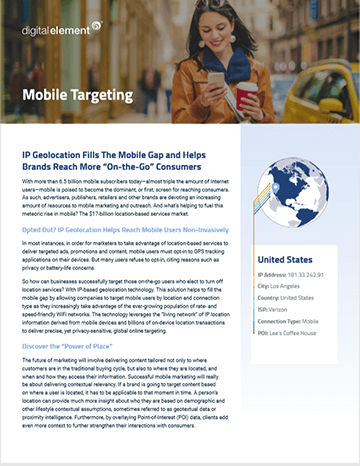IP geolocation fills the mobile gap and helps brands reach more “on-the-go” consumers
With more than 6.5 billion mobile subscribers today—almost triple the amount of Internet users—mobile is poised to become the dominant, or first, screen for reaching consumers. As such, advertisers, publishers, retailers and other brands are devoting an increasing amount of resources to mobile marketing and outreach. And what’s helping to fuel this meteoric rise in mobile? The $17-billion location-based services market.
Opted Out? IP Geolocation Helps Reach Mobile Users Non-invasively
In most instances, in order for marketers to take advantage of location-based services to deliver targeted ads, promotions and content, mobile users must opt-in to GPS tracking applications on their devices. But many users refuse to opt-in, citing reasons such as privacy or battery-life concerns.
So how can businesses successfully target those on-the-go users who elect to turn off location services? With IP-based geolocation technology. This solution helps to fill the mobile gap by allowing companies to target mobile users by location and connection type as they increasingly take advantage of the ever-growing population of rate- and speed-friendly Wi-Fi networks. The technology leverages the “living network” of IP-location information derived from mobile devices and billions of on-device location transactions to deliver precise, yet privacy-sensitive, global online targeting.
Discover the “Power of Place”
The future of marketing will involve delivering content tailored not only to where customers are in the traditional buying cycle, but also to where they are located, and when and how they access their information. Successful mobile marketing will really be about delivering contextual relevancy. If a brand is going to target content based on where a user is located, it has to be applicable to that moment in time. A person’s location can provide much more insight about who they are based on demographic and other lifestyle contextual assumptions, sometimes referred to as geotextual data or proximity intelligence.
With Digital Element’s geolocation and IP Intelligence technology, marketers, advertisers, retailers and more can leverage our data to incorporate geotextual, or location- and context-aware, business strategies to encourage smarter, more relevant interactions with consumers. Best of all, marketers can reach audiences across multiple screens, creating more engaging interactions with today’s “always on” users.
Benefits
- Improve Engagement – Deliver location-based content, promotions, news, offers, etc. without requiring users to opt-in to location-based services.
- Build Brand Loyalty – Increase trust by automatically delivering engaging and relevant content using privacy-sensitive IP geolocation data.
- Increase ROI – Incorporate geotextual data to increase reach and relevancy for geographically targeted ads, promotions and coupons.
- Capture Point-in-Time Revenue – Move customers more quickly from research to action by reaching them at a point in time when buying decisions are made.
